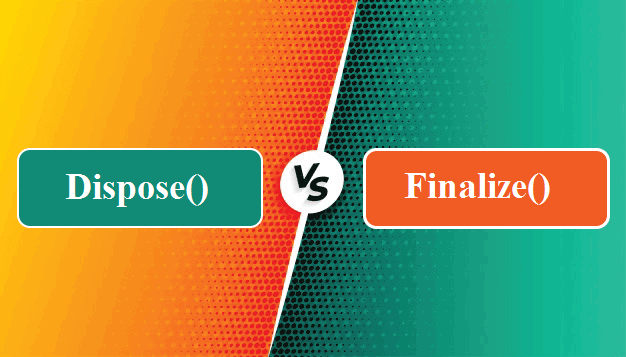Difference between Dispose and Finalize in C#The C# dispose() and finalize() methods are used to liberate the unmanaged resources kept by an object. The dispose() method is described within the IDisposable interface, but the finalize() method is described within the class object. The primary distinction between these methods is that the dispose() method has to be explicitly invoked by the user. In contrast, the garbage collector (GC) invokes the finalize() method just before the object is destroyed. In this article, you will learn the difference between dispose() and finalize(). But before discussing the differences, you must know about Primary dispose() and finalize() with their syntax. What is Dispose()?The dispose()method releases any unmanaged resources owned by a class object. Unmanaged resources include files, data connections, and many others. The function dispose() is defined in the interface IDisposeable, and the class implements it by implementing the interface IDisposable. It is not invoked by default, and the programmer must manually implement it when creating a custom class that others will use. Syntax: There is a syntax of Dispose() method. You may see that the method is defined as public in the above code. It is due to this function is described in the interface IDisposable and must be executed by the class that implements that interface. As a result, the method is made public to enable access to the implementing class. Programmer code manually invokes this method as it is implemented to invoke. The method's speed is rapid, instantly releasing the resources held by a class's object. What is Finalize()?The finalize() method is described in the object class. It is utilized for cleaning purposes. When an object's reference is not used for an extended time, the garbage collector calls this function. The garbage collector (GC) automatically frees managed resources. If you wish to free unmanaged resources such as file manages, data connections, etc., the finalize() method must be implemented manually. The GC calls the finalize() method shortly before entirely destroying the item. The finalize() method is executed with the aid of the destructor. The java.lang.object class defines the finalize() method. This method has been designated as protected and is not marked as public to prevent other classes from accessing it. The finalize() method may reduce program speed because it does not immediately free memory. Syntax: There is a syntax of Finalize() method. In the above syntax, the finalize() function is marked as protected. The main reason for this is that the finalize() function cannot be accessed from outside the class and can only be accessed by the garbage collector. The finalize() function has an impact on performance because it does not immediately free memory. Using destructors in C#, the finalize () method is invoked automatically. Key differences between Dispose() and Finalize()
There are various key differences between Dispose() and Finalize() methods. Some of the key differences between Dispose() and Finalize() methods are as follows:
Head-to-head comparison between Dispose() and Finalize()Here, you will learn the head-to-head comparisons between the Dispose() and Finalize() methods. The main differences between the Dispose() and Finalize() methods are as follows.
ConclusionThis article explained the distinction between the dispose() and finalize() methods in C#. The main distinction between these methods is that dispose() must be explicitly invoked by the programmer. In contrast, finalize() method is invoked by the GC before the object is destroyed. It is recommended to use the dispose() method instead of the finalize() method because it is faster. It may also be invoked whenever it is needed.
Next TopicDifference between
|
 For Videos Join Our Youtube Channel: Join Now
For Videos Join Our Youtube Channel: Join Now
Feedback
- Send your Feedback to [email protected]
Help Others, Please Share










